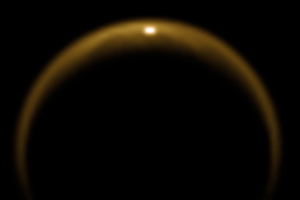 NASA's Cassini spacecraft captured this image of sunlight
NASA's Cassini spacecraft captured this image of sunlight
reflecting off of a lake on the surface of Saturn's moon Titan.
Credit: NASA/CassiniIn a literal flash of insight—well, "infrared sight," really--NASA's Cassini spacecraft has confirmed the existence of lakes of liquid in the Northern Hemisphere of Saturn's moon, Titan. That's really big news for scientists, and for those like me who absolutely love to envision the sweep of the landscape on alien worlds, be they science fiction or, as in this case, fact….
The evidence for the existence of lakes on Titan has been building since 2004, when the Cassini spacecraft, and its Titan-landing probe Huygens, arrived in the Saturn system and began collecting data.
First it was imagery from the Huygens camera as it descended through Titan's thick, hazy atmosphere: what looked like dark, flat, featureless regions defining apparent coastlines along solid terrain, as well as dentritic patterns like river channels draining into them.
Then it was imagery from Cassini's smog-penetrating infrared cameras showing numerous systems that looked for all the moon like giant lakes—on the order of size of Earth's Great Lakes. Cassini radar bouncing off the surfaces suggested that they were exceptionally flat, as one expects a watery surface to be.
Then there was confirmation of surface liquid in Titan's Southern Hemisphere—but not in the north, where the lake-like shapes were by far more numerous…an apparent land o' lakes.
